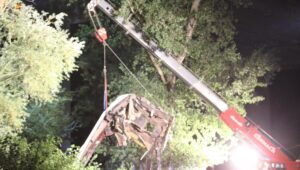Tsunami waves caused by an undersea volcano have flooded the Pacific Island country of Tonga, where entire towns have been inundated with water and scientists warn the main island could be blanketed in volcanic ash.
Videos shared on social media after the eruption showed people running for higher ground as the one metre high floods hit coastal areas and made their way farther inland while the sky darkened with ash.
A video shot from the roof of a building on the coast showed large waves breaching the coastal wall seconds apart, while a video shot from the New Zealand high commission in Nuku’alofa, where people ran for shelter, showed the downtown area of Patangata had been completely submerged, including the Royal Palace and Tonga’s largest bank.
Another video, shot inside a church, showed children crying out as water surrounded the building and waves begin lapping up against the windows. In a video posted to YouTube after the eruption, Abraham Leilua begins by telling his followers that “it’s not that bad” but within minutes, as the water rises, saying: “I have to run for my life” before ending the video.
Blake Smith-Tatafi, a Tongan based in Australia, said they were praying and in fear. “If you don’t know, the island of Tonga is flat. This leaves their people with nowhere of realistic safety to evacuate. Villages completely underwater. We haven’t had contact for hours now. This is a crisis,” he said.
Pita Taufatoua, a Tongan Olympian based in Australia, said he had not heard from his father or family in Ha’apai, the lowest lying islands in Tonga.
“Initial reports of damage have been catastrophic and all communications with Tonga have been wiped out,” he said. “Whilst I can’t assist family at this moment I will focus on country as more information comes out.”
Other than the videos posted online, little was known about the damage caused as internet connectivity was lost at about 6.40pm local time. Southern Cross Cable Network said on Sunday that it had been able to confirm contact with a communications centre in Tonga and work was under way to have internet and phone links restored.
Tonga’s Hunga Tonga volcano just had one of the most violent volcano eruptions ever captured on satellite. pic.twitter.com/M2D2j52gNn
An internet post on Sunday morning stated that the Tongan prime minister, Siaosi Sovaleni, said the tsunami warning remained in place and much of the country had sustained serious damage. Australia’s foreign affairs department said its high commission had received no reports of casualties.
New Zealand’s prime minister, Jacinda Ardern, said the situation in Tonga was “hugely concerning”.
“Communication, as a result of the eruption, has been difficult, but our defence force team and ministry of foreign affairs are working as we speak to establish what’s needed and how we can help,” she said.
New Zealand has made an initial NZ$500,000 available to Tonga and has dispatched an aerial surveillance aircraft to assess the damage.
The Save the Children Fiji chief executive, Shairana Ali, said it was closely monitoring the situation and prepared to respond. “Our thoughts have been for the safety of our Tongan brothers and sisters, and Save the Children is well placed to assist as needed,” she said, adding that the “booms from the eruption of the Tonga volcano could be clearly heard in Fiji”.
The volcano, Hunga Tonga-Hunga Ha’apai, at 1,800m high and 20km wide, is 65km north of Tonga’s capital, Nuku’alofa. US Storm Watch said the eruption was one of the most violent ever captured on satellite, while the Tonga geological service said the gas, smoke and ash from the eruption reached 20km into the sky.
The eruption could be heard as far away as 2,300km away in New Zealand, while tsunami warnings were in force at various times across the Pacific, including in Australia, Japan and the US. Some coastal communities in Fiji and Vanuatu were damaged by large waves, while tidal surges were reported to have damaged harbours and coastal parks along the US west coast.
Tonga has also been hit by two category five cyclones in the last five years: Cyclone Harold in April 2020 and Cyclone Gita in 2018.





